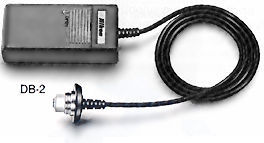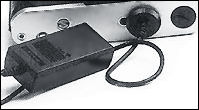Caution: Keep batteries away from infants and small children. In case a battery Is accidentally swallowed, call a doctor immediately as the material inside the batteries can cause serious problems. After correct installation, insert the holder back into the battery chamber using a coin to screw it securely into place and your camera will be ready to function. If it doesn't, open and check the polarity marks on the cells.
 |
Make sure the battery contacts (+ or - surfaces) are clean. As most problem arised from automatic cameras were battery related. Sometimes, even an invisible film left behind by your oily fingers can prevent proper contact. |
Generally, as a guideline for normal camera maintenance, never hold any cells in the center, only at the side. You may use a clean cloth to clean off a light layer of oxidation, or a pencil eraser from your children pencil box to remove heavier deposits that may deposited at the cells' polarity marks front and back or at the contact points (battery clip) inside the camera battery compartment.
Should the battery be left in the battery chamber for a long period, insufficient contact may occur due to battery leakage. Thus, it is good practice to periodically clean the battery (Or consider remove the cells from the camera) and the contact section in the battery chamber with a soft cloth. If the battery chamber is contaminated by a leaking battery, remove the battery at once and clean the chamber. Before doing so, try to clean (Sounds stupid, but a pencil eraser is very effective for this kind of job) and removed any deposits remains inside, especially the clips housed inside the compartment and do a few test shots. If the metering circuit still inactive, I would strongly suggest you to send for examination of the damage done.
Guides that provided in the original Instruction Manual on Handling of Batteries
1) Remove
the battery (batteries) and store the camera with a desiccant. *A desiccant will
lose its effect after absorbing a certain amount of moisture. Occasionally replace
it with new one.
2) If you do not intend to use the camera for a long time, store it after removing
the battery (batteries) to protect the camera from battery leakage.
3) When storing the camera, it is recommended to store it with a desiccant in a plastic
bag. Note, however, that storing the leather camera cases in plastic bags may cause
the leather to deteriorate. Keep the batteries in a cool, dry place.
4) Leaving the camera unused for a long period of time will allow mold to grow and
result in malfunction. To prevent this, insert a battery (batteries) once a month
and release the shutter a few times.
Keep batteries out of the reach of children. If a battery is swallowed, immediately
contact a physician.
Use the following battery (batteries):
One 3-V lithium battery (CR-1/3N type)
Two 1.55-V silver batteries (SR44 type)
Two 1.5-V alkaline batteries (LR44 type)
5) Before important photographic occasions, replace the battery (batteries) well
before the end of its life (their lives), or at least have spare batteries handy.
6) Turn the power to the camera off when replacing battery (batteries)
7) When changing the battery (batteries), fold the film-advance lever and insert
a new battery (new batteries) with the + and - ends positioned correctly.
8) The batteries supplied are for checking operation at time of purchase. Their lives
may be shorter than those of new ones.
9) Stains on the battery poles may cause lack of contact. Wipe the batteries with
a dry cloth before inserting.
10) Use a fresh battery (batteries) when using the camera at a low temperature:
11) The camera may not operate with exhausted batteries. It is recommended to carry
spare batteries, and keep them warm for alternate use.
12) The number of rolls of film rolls that can be shot becomes smaller at low temperatures.
However, battery power may recover when the temperature returns to normal.
13) Do NOT throw batteries into a fire.
14) Do NOT throw batteries into a fire, short-circuit, disassemble, heat or charge
batteries.
 |
 |
Anti-Cold Battery Pack DB-2 |
In such cases,
consider use a Anti-Cold Battery Pack DB-2, which accepts two M-type batteries,
as an alternative power supply to the batteries inside the camera body. Simply connect
the DB-2 to the camera body, then slip the assembly inside your pocket or coat to
keep it warm. This assures that the camera's metering system will function even in
very cold temperatures.
| c l o
s e |
Standard
production Nikon FM Series models:-
Nikon FM | Nikon FM2 | Nikon FM2n | Nikon FM10 | Nikon FM3a |
Known
variants:-
Nikon
FM Gold
| Nikon
FM2/T
| Nikon
FM2N Tropical Set
| Nikon
FM2/T Limited Edition
| Nikon
FM2N LAPITA
|
Nion
FM2n Millennium 2000
|
Back | Index Page of Instruction
Manual Section of Nikon FM3A
|
Back | Index Page - Other
Issues < Index Page >
| Message Board | for
your favourite Nikon
FM Series SLR models
| Message
Board | for your Nikon
Optics in a shared environment
| Message Board | Specifically for Dispose or Looking for Nikon/Nikkor
Photographic Equipment
| Back | Main Index Page of Nikon FM series Bodies
Shared Resources: MD-11 | MD-12 | Focusing Screens | Titanium Shutter | ORIGINAL dedicated Flash Units -SB-16 | SB-15 | SB-10 or other Options | Databack | Nikkor lens mount (related info)
Others:- Nikon AF-TTL Speedlights
| SB-20 (1986)
|
SB-22
(1987)
| SB-23 | SB-24 (1988) |
SB-25 (1991/2) |
SB-26 (1994)
| SB-27(1997)
| SB-28 (1997) |
Nikon
SB-29(s)
(2000) |
Nikon
SB-30
(2003) |
Nikon
SB-600
(2004) |
Nikon
SB-800 (2003)
(updated)
Nikon AF-TTL Speedlight DX-Series: Nikon SB-28DX (1999)
| SB-50DX (2001) |
SB-80DX
(2002)
(updated)
Nikon
BC-flash Series |
Original Nikon Speedlight
SB-2
| SB-3
| SB-4
| SB-5
| SB-6
| SB-7E
| SB-8E
| SB-9
| SB-E
| SB-10
SB-11
| SB-12 | SB-14 | SB-140 UV-IR| SB-15 | SB16A | SB-17 | SB-18, SB-19 | SB-21A (SB-29) Macro flash | Flash Accesories | SF-1
Pilot Lamp
Instruction
Manual: Nikon FM (HTML | PDF) | Nikon FM-10 (HTML) | Nikon FM2n's
User's Manual
available only in HTML format (6
parts) | Nikon FM3A (HTML)
Specifications: Nikon FM, FM-10, FM2, FM2n and FM3A
Main Reference Map: (HTML) Nikon FM, FM2, FM-10, FM2n (Applicable
to FM2T, FM2 "Year of the Dog"; Millennium 2000") and FM3A
| Nikon F | Nikon F2 | Nikon F3 | Nikon F4 | Nikon F5 | Nikon F6 | Nikkormat / Nikomat | Nikon FM | Nikon FE/ FA | Nikon EM/FG/FG20 | Nikon Digital SLRs | Nikon - Other models |
Nikon Auto Focus Nikkor lenses:- Main Index Page
Nikon Manual Focus Nikkor lenses:- Fisheye-Nikkor Lenses - Circular | Full Frame |
Ultrawides Lenses - 13mm15mm18mm20mm | Wideangle Lenses - 24mm28mm35mm | Standard Lenses - 45mm 50mm 58mm | Telephoto
Lenses - 85mm105mm135mm180mm & 200mm | Super-Telephoto Lenses - 300mm 400mm 500mm 600mm 800mm 1200mm |
 Index Page |
Special
Application lenses: Micro-Nikkor Lenses - 50mm~55mm -60mm 85mm -105mm 200mm Micro-Zoom 70-180mm Perspective Control (PC) - 28mm 35mm PC-Micro 85mm Dedicated Lenses for Nikon F3AF: AF 80mm f/2.8 | AF 200mm f/3.5 EDIF Depth of Field Control (DC): 105mm 135mm Medical Nikkor: 120mm 200mm Reflex-Nikkor Lenses - 500mm 1000mm 2000mm Others: Noct Nikkor | OP-Nikkor | UV Nikkor 55mm 105mm | Focusing Units | Bellows-Nikkor 105mm 135mm Nikon Series E Lenses: 28mm35mm50mm100mm135mm | E-Series Zoom lenses: 36~72mm75~150mm70~210mm |
MF Zoom-Nikkor Lenses: 25~50mm | 28~45mm | 28~50mm | 28~85mm | 35~70mm | 36~72mm E | 35~85mm | 35~105mm | 35~135mm | 35~200mm | 43~86mm | 50~135mm | 50~300mm | 70~210mm E | 75~150mm E | 80~200mm | 85~250mm | 100~300mm | 180~600mm | 200~400mm | 200~600mm | 360~1200mm | 1200~1700mm
Tele-Converters: TC-1 | TC-2 | TC-200 | TC-201 | TC-300 | TC-301 | TC-14 | TC-14A | TC-14B | TC-14C | TC-14E | TC-16 | TC-16A | TC-20E
Recommended links to understand more technical details
related to the Nikkor F-mount and production Serial Number:
http://rick_oleson.tripod.com/index-153.html by: my
friend, Rick Oleson
http://www.zi.ku.dk/personal/lhhansen/photo/fmount.htm by: Hansen,
Lars Holst
http://www.mir.com.my/rb/photography/hardwares/nikonfmount/lens2.htm
http://www.photosynthesis.co.nz/nikon/serialno.html
W A R N I N G: The New G-SERIES Nikkor lenses have no aperture ring on the lens, they CANNOT ADJUST APERTURES with any of these manual focus Nikon FE series SLR camera models; please ignore some portion of the content contained herein this site where it relates.
|
Back | Main Index Page of Nikkor Resources
|
Back | Main Index Page of Pictorial
History of Nikon SLRs
| Message Board | for your Nikkor optics ("shared" because I do wish some of you to expose to other's perspective as well. Isn't it a sad sate to see photography has to be segmented into different camps from the use of various labels)
about this photographic web site
Home - Photography in Malaysia |
Credit: To all the good people who has contributed their own experience, resources or those who are kind enough granting us permission to use their images appeared in this site. Mr. MCLau®, who has helped to rewrite some of the content appeared this site. Chuck Hester® who has been helping me all along with the development of all these Nikon websites;LarsHolst Hansen, 'Hawkeye' who shares the same passion I have; Ms Rissa, Sales manager from Nikon Corporation Malaysia for granting permission to use some of the official content; TedWengelaar,Holland who has helped to provide many useful input relating to older Nikkor lenses; Some of the references on production serial numbers used in this site were extracted from Roland Vink's website; HiuraShinsaku from Nikomat Club Japan. t is also a site to remember a long lost friend on the Net. Note:certain content and images appeared in this site were either scanned from official marketing leaflets, brochures, sales manuals or publications published by Nikon over the years and/or contribution from surfers who claimed originality of their work for educational purposes. The creator of the site will not be responsible for may discrepancies arise from such dispute except rectifying them after verification."Nikon", "Nikkormat", "Nippon Kokagu KK" & "Nikkor" are registered tradename of Nikon Corporation Inc., Japan. Site made with an Apple IMac.